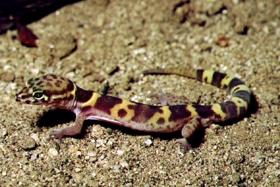
Western Banded Gecko
The Western Banded Gecko, or Coleonyx variegatus, is no stranger to beating the heat; their nocturnal lifestyle is ideal for the sizzling desert climate.
You are more likely to encounter them on a night stroll under the stars than in the mid-day sun, however. And, though many confuse the Western Banded Gecko with a young Gila Monster, they are much smaller and lack any venomous characteristics.
Distinguishing Features
This delicate-in-appearance lizard rarely surpasses 6 inches, or about 15 centimeters. Don't let that 6 inches fool you; up to half of their size is their bulky tail. Pale-pink and brown-banded translucent skin distinguishes it from all other lizards that live in the same desert surroundings. The head and body are speckled with light brown. The brown bands are vibrant in young Western Banded Geckos, and then morph into blotches, or spots, with age. The small scales that cover their body are soft to touch, and slender toes leave no room for pads. Movable eyelids and vertical pupils also set them apart from other lizards in these warm habitats. Male Western Banded Geckos can be distinguished from females by the protruding spurs near the sides at the base of the tail.
Where Are They?
You can spot the Western Banded Gecko in rocky or sandy desert areas in the American Southwest. They are fond of open, dry deserts, desert grasslands, and in sunny canyons. You can spot them, or one of the eight subspecies, in Saguaro National Park, Grand Canyon National Park, Joshua Tree National Park, and Glen Canyon National Recreation Area, to name just a few locations they call home.
Behavior And Escape Routes
Like other geckos, these lizards avoid the day heat and prefer the cool night air. They seek shelter during the day near or under rocks, burrows, and spaces beneath vegetative debris, and even trash piles if necessary. They frequent rodent burrows as they hunt insects, spiders, small arthropods, and baby scorpions. The Western Banded Gecko stalks its prey, capturing and crushing it with its jaws in a final, fatal lunge. The small gecko is one of the few reptiles credited with controlling the scorpion population, by eating their young. The Western Banded Gecko can also mimic a scorpion, by turning its tail upwards, and waving it to repel predators.
In addition to this deception, Western Banded Geckos use other methods to divert predators. Be forewarned: if you plan on catching a Western Banded Gecko, be prepared to hear a squeak or chirp in disagreement. You may even see them detach their tail. Their tail has particular fracture planes, allowing the lizard to easily detach and escape, similar to other lizards. Blood vessels surrounding the tail rapidly close, so they can prevent blood loss. Regrowth of their tails happens quickly, as it is mostly made up of cartilage. Though the tail serves as an easy escape route, it means a lot to a Western Banded Gecko: that's where it stores food and water. Their tail allows these animals to survive during lean times, up to nine months. As you can imagine, losing a tail puts their life in danger.
The Cycle Of Life
Western Banded Geckos breed during spring months, April and May. Females lay from one to three clutches of two eggs from May through September. Hatchlings appear about 45 days later, from July through November.



Add comment